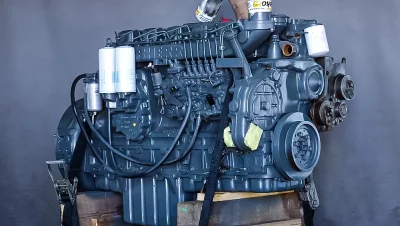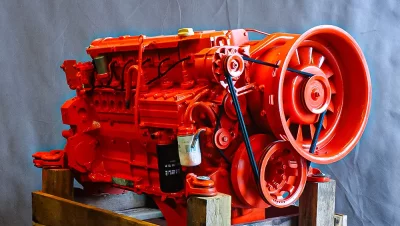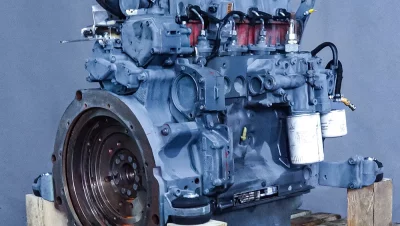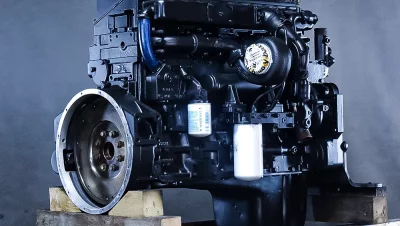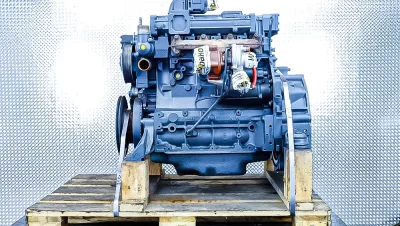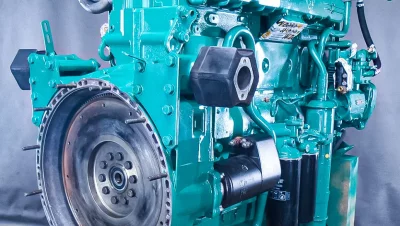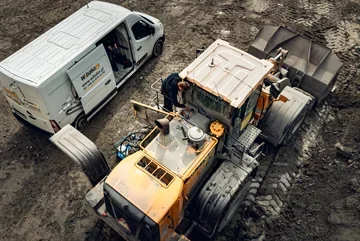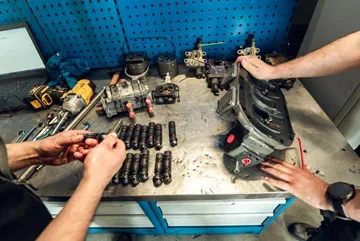Engine overhaul Liebherr D926 TI-E (270 kW) in Liebherr MK 88 mobile tower crane
The mobile tower crane from the Liebherr MK 88 series is an exceptional design that combines the mobility of a self-propelled crane with the functionality of a tower crane. Thanks to the use of advanced folding technology and impressive reach, the MK 88 is valued on construction sites with limited space. The drive of this model is based on a robust, six-cylinder diesel engine Liebherr D926 TI-E with a power of 270 kW, which has long been regarded as one of the most durable and economical units in the off-highway machine class.
Our WIBAKO service received the MK 88 operating in the Małopolskie Voivodeship, near the city of Kraków. The operator reported a loss of power, uneven operation, and white smoke appearing under load. Preliminary diagnostics indicated possible issues with the cooling system and suspicion of engine head damage. After conducting tests on the machine and then verifying in the workshop, it was confirmed that the unit required a comprehensive rebuild. In the following part of the article, we describe the complete service process we carried out – from diagnostics to final tests on our engine dynamometer.
Preliminary diagnostics in the machine
After receiving the report, our mobile service went to the work site of the Liebherr MK 88 crane. During the first start attempts, difficulties in starting and slight "stuttering" of the engine at idle were noticed. As the load increased, white smoke appeared, and the temperature of the coolant rose.
We applied a CO2 test in the cooling system, which indicated the presence of exhaust gases in the coolant. The next step was a compression test on the cylinders, which confirmed significant leakage in two of them. Endoscopy revealed micro-cracks in the water channels of the head. Due to the condition of the unit, a decision was made to fully disassemble the engine and transport it to our facility in Kojszówka.
Engine disassembly from the Liebherr MK 88 crane
Disassembling the engine in mobile tower cranes requires special caution due to the specific frame construction and numerous hydraulic and electrical components routed in a tight working space. According to procedures, a crane provided by the client was used, allowing for the safe extraction of the power unit from the crane's engine compartment.
The disassembly process included: disconnecting hydraulic hoses, unplugging the electrical system, securing intake and exhaust pipes, removing the radiator, disconnecting the fuel system, and disassembling external accessories. Each element was appropriately labeled to facilitate later assembly. The engine was then transported to the WIBAKO headquarters in Kojszówka, where a full verification began.
Verification of the Liebherr D926 TI-E engine in the workshop
The verification began with a detailed disassembly of the power unit into parts, followed by washing them in pressure and ultrasonic washers. After exposing key elements, the previously identified cause was confirmed – cracks in the head in several places and damage resulting from overheating.
We checked the crankshaft (measuring runout, analyzing journals), connecting rods (measuring twist, weight, cracks), cylinder liners (signs of seizure), pistons, rings, the injection pump, and injectors. The turbocharger also showed excessive lateral play, qualifying it for regeneration.
Repair process
Crank-piston system
A full range of work was performed on the crank-piston system: honing of the liners, replacement of piston rings, inspection of pistons (some of which were replaced), grinding of the crankshaft, and installation of new bearings. The connecting rods were re-measured after regeneration and approved for assembly.
Engine head
The Liebherr D926 TI-E head was in a condition unsuitable for further operation. Due to numerous cracks, it was decided to install another one after full regeneration. The head was planed, received new guides and valves, and then underwent a leak test in a water bath.
Fuel system
The injection pump was sent to an external facility specializing in the regeneration of Liebherr fuel pumps. Upon return, it underwent calibration and bench testing. The injectors were tested on a test bench – three specimens required replacement of the tips.
Accessories
The turbocharger was regenerated by replacing the core, balancing the rotor, and performing a leak test. The starter and alternator underwent inspection and bearing replacement. Hoses, O-rings, and other seals were replaced with new ones. A new set of gaskets and filters was also prepared.
Professional assembly of the engine
The assembly of the unit was carried out according to Liebherr's manufacturer standards. All tightening torques were performed using torque wrenches. The timing system was set according to factory parameters. After assembly, a rotation test of the engine was conducted over a full range of 720 degrees – without resistance or disturbing sounds.
Test on WIBAKO engine dynamometer
Our engine dynamometer is one of the largest conveniences that distinguish WIBAKO from many other companies operating in the off-highway engine repair market. Every regenerated engine, including the Liebherr D926 TI-E, undergoes a full cycle of load tests. In the first phase, the engine runs for about 16 hours under a small load of around 20-30 percent of nominal power. This is a period for breaking in components and observing the stability of operating parameters.
Subsequently, a series of full load tests are conducted, where various parameters are checked, including: power, torque, operating temperatures, oil and fuel pressures, tightness, and the unit's response to sudden load changes. Each stage of the test is closely monitored and recorded in logs. Only after achieving full compliance with factory standards does the engine receive a dynamometer test certificate.
Engine installation in the MK 88 crane
After the tests were completed, the engine was prepared for installation in the Liebherr MK 88 crane. Our mobile service went to the client again, using the crane provided on the construction site. Introducing the engine into the compartment required precise positioning of the mounting points and connecting the entire infrastructure of accessories.
The installation included: installing air hoses, mounting the radiator, connecting hydraulic hoses, connecting the fuel system, installing the clutch, and precisely fitting the electrical accessories. All connections underwent double leak testing. After the initial start-up, tests were conducted in the presence of the operator – checking the crane's proper operation, absence of leaks, and stability of revolutions.
After the installation was completed, a handover protocol was signed, and the machine owner received recommendations for further operation and the first inspections.
Engine maintenance after repair
Every engine repaired at WIBAKO is covered by a warranty and service recommendations. We recommend performing the first inspection after 50 operating hours, which includes replacing filters, checking the condition of the oil system, inspecting tightness, and a general assessment of the unit's operation. Subsequent inspections should be conducted every 250 operating hours or every 3 months.
Where is the Liebherr D926 TI-E engine used?
This engine is found in: Liebherr self-propelled cranes, handling machines, specialized vehicles, municipal equipment, and selected MK series tower cranes. It is characterized by high durability, economical operation, and great load flexibility.
Summary
The comprehensive rebuild of the Liebherr D926 TI-E engine in the MK 88 crane allowed for the full restoration of the machine's efficiency. Thanks to tests on our professional engine dynamometer, the client received assurance that the unit operates according to factory parameters. WIBAKO's mobile service provided quick installation and full technical support on-site. We recommend the next inspection be performed after 50 operating hours, which will help maintain the unit in optimal condition for a long time.
TITLE
ADDITIONAL INFORMATION





